Operations Management Strategies: A Case Study of Unilever Plc
VerifiedAdded on 2023/06/14
|10
|3765
|404
Essay
AI Summary
This essay provides an in-depth analysis of operations management principles, using Unilever Plc as a case study. It examines operational scheduling techniques such as forward and backward scheduling, layout planning processes focusing on efficient resource allocation, and work system processes that coordinate daily activities. Furthermore, the essay discusses the importance of inventory management policies in controlling production costs, highlighting techniques like ABC analysis and re-order levels to optimize inventory investments and ensure timely product availability. The study emphasizes how effective operations management, including layout and work systems, significantly impacts Unilever's efficiency, productivity, and customer satisfaction by ensuring smooth supply chains and minimizing waste.
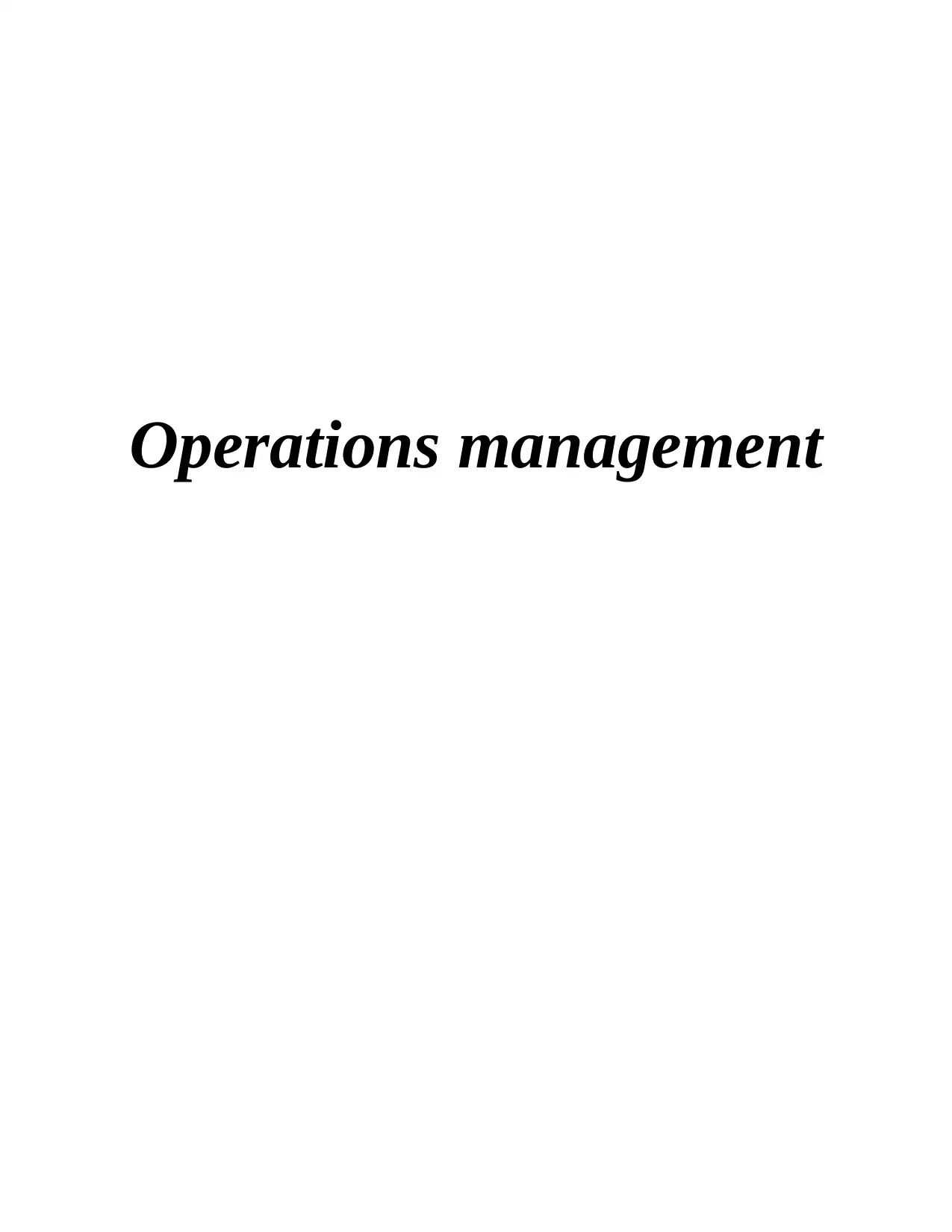
Operations management
Paraphrase This Document
Need a fresh take? Get an instant paraphrase of this document with our AI Paraphraser
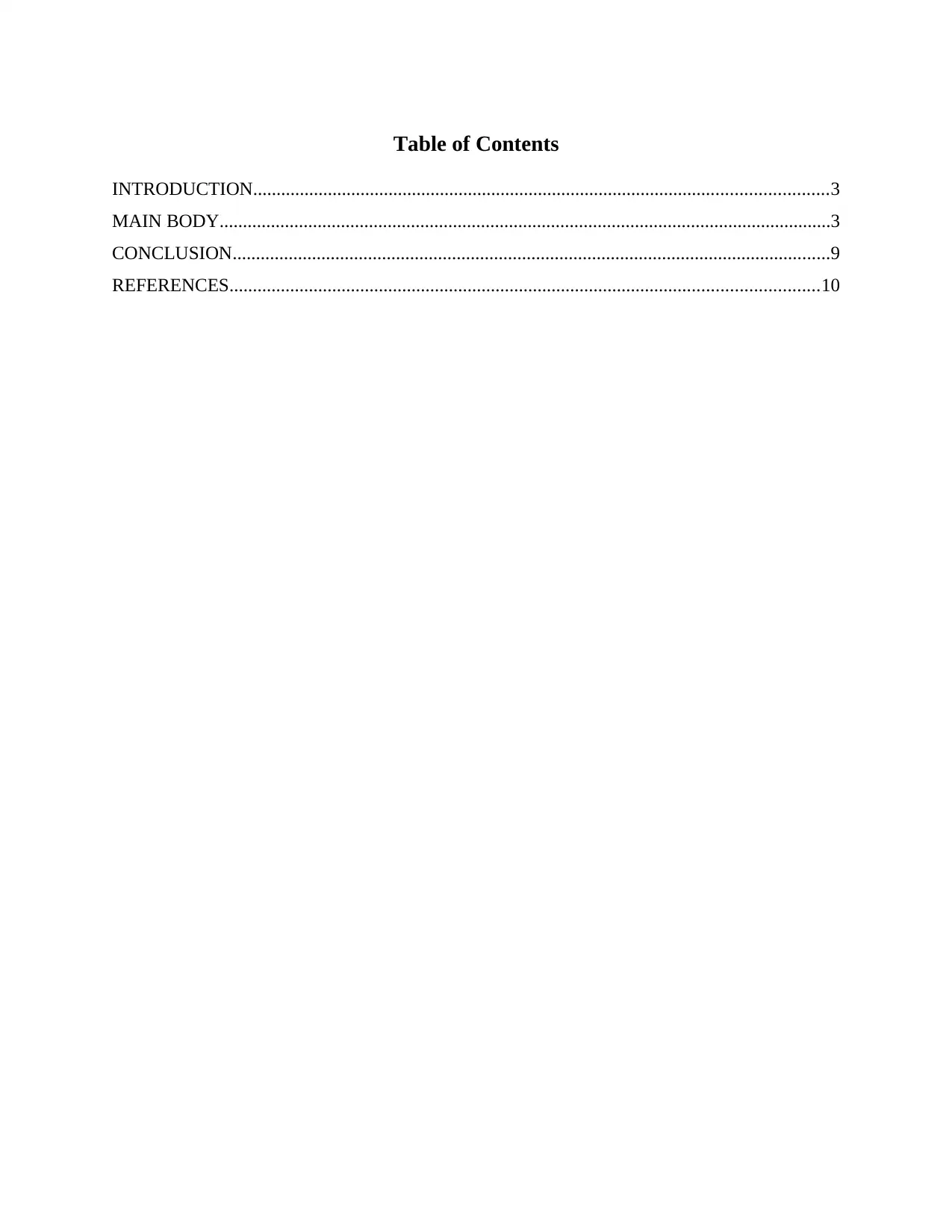
Table of Contents
INTRODUCTION...........................................................................................................................3
MAIN BODY...................................................................................................................................3
CONCLUSION................................................................................................................................9
REFERENCES..............................................................................................................................10
INTRODUCTION...........................................................................................................................3
MAIN BODY...................................................................................................................................3
CONCLUSION................................................................................................................................9
REFERENCES..............................................................................................................................10
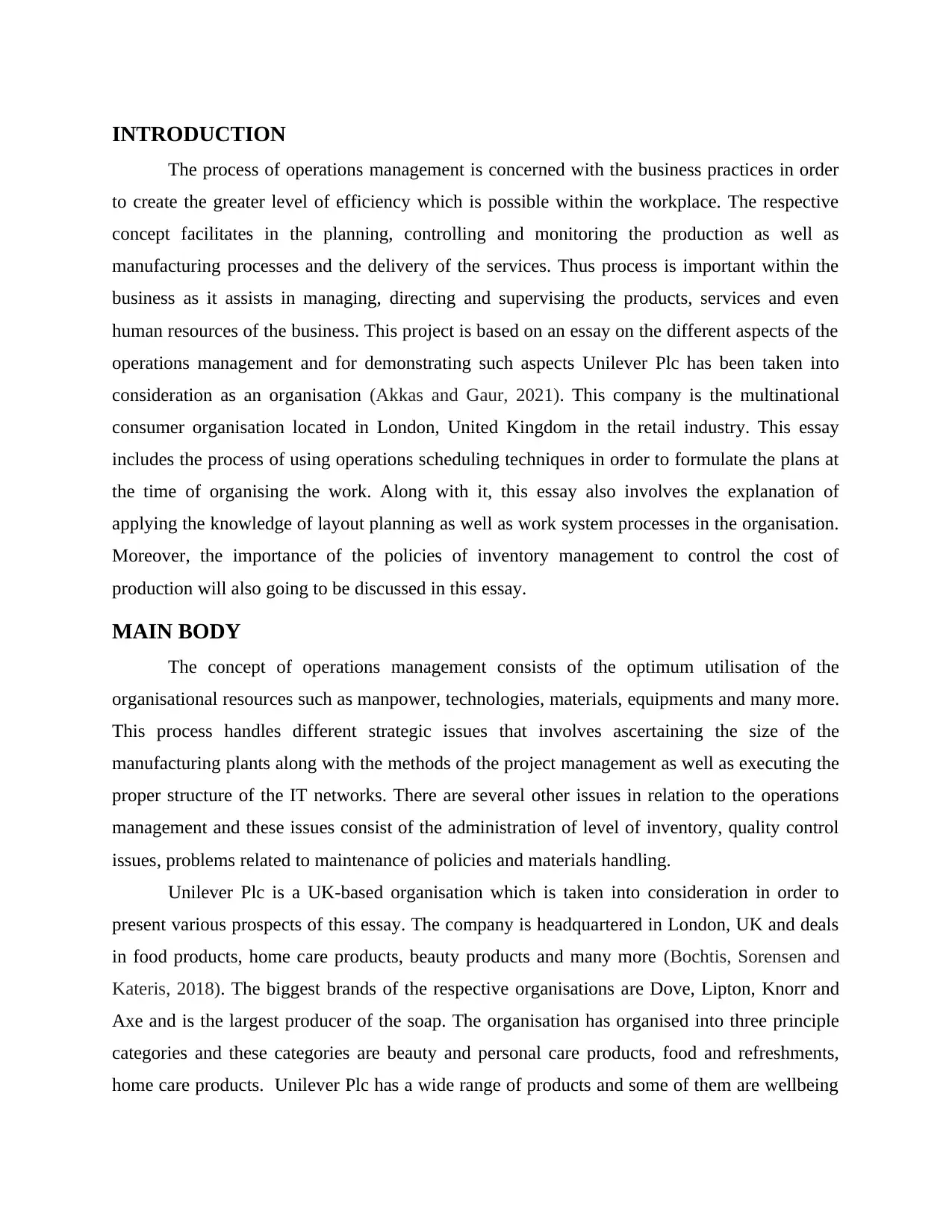
INTRODUCTION
The process of operations management is concerned with the business practices in order
to create the greater level of efficiency which is possible within the workplace. The respective
concept facilitates in the planning, controlling and monitoring the production as well as
manufacturing processes and the delivery of the services. Thus process is important within the
business as it assists in managing, directing and supervising the products, services and even
human resources of the business. This project is based on an essay on the different aspects of the
operations management and for demonstrating such aspects Unilever Plc has been taken into
consideration as an organisation (Akkas and Gaur, 2021). This company is the multinational
consumer organisation located in London, United Kingdom in the retail industry. This essay
includes the process of using operations scheduling techniques in order to formulate the plans at
the time of organising the work. Along with it, this essay also involves the explanation of
applying the knowledge of layout planning as well as work system processes in the organisation.
Moreover, the importance of the policies of inventory management to control the cost of
production will also going to be discussed in this essay.
MAIN BODY
The concept of operations management consists of the optimum utilisation of the
organisational resources such as manpower, technologies, materials, equipments and many more.
This process handles different strategic issues that involves ascertaining the size of the
manufacturing plants along with the methods of the project management as well as executing the
proper structure of the IT networks. There are several other issues in relation to the operations
management and these issues consist of the administration of level of inventory, quality control
issues, problems related to maintenance of policies and materials handling.
Unilever Plc is a UK-based organisation which is taken into consideration in order to
present various prospects of this essay. The company is headquartered in London, UK and deals
in food products, home care products, beauty products and many more (Bochtis, Sorensen and
Kateris, 2018). The biggest brands of the respective organisations are Dove, Lipton, Knorr and
Axe and is the largest producer of the soap. The organisation has organised into three principle
categories and these categories are beauty and personal care products, food and refreshments,
home care products. Unilever Plc has a wide range of products and some of them are wellbeing
The process of operations management is concerned with the business practices in order
to create the greater level of efficiency which is possible within the workplace. The respective
concept facilitates in the planning, controlling and monitoring the production as well as
manufacturing processes and the delivery of the services. Thus process is important within the
business as it assists in managing, directing and supervising the products, services and even
human resources of the business. This project is based on an essay on the different aspects of the
operations management and for demonstrating such aspects Unilever Plc has been taken into
consideration as an organisation (Akkas and Gaur, 2021). This company is the multinational
consumer organisation located in London, United Kingdom in the retail industry. This essay
includes the process of using operations scheduling techniques in order to formulate the plans at
the time of organising the work. Along with it, this essay also involves the explanation of
applying the knowledge of layout planning as well as work system processes in the organisation.
Moreover, the importance of the policies of inventory management to control the cost of
production will also going to be discussed in this essay.
MAIN BODY
The concept of operations management consists of the optimum utilisation of the
organisational resources such as manpower, technologies, materials, equipments and many more.
This process handles different strategic issues that involves ascertaining the size of the
manufacturing plants along with the methods of the project management as well as executing the
proper structure of the IT networks. There are several other issues in relation to the operations
management and these issues consist of the administration of level of inventory, quality control
issues, problems related to maintenance of policies and materials handling.
Unilever Plc is a UK-based organisation which is taken into consideration in order to
present various prospects of this essay. The company is headquartered in London, UK and deals
in food products, home care products, beauty products and many more (Bochtis, Sorensen and
Kateris, 2018). The biggest brands of the respective organisations are Dove, Lipton, Knorr and
Axe and is the largest producer of the soap. The organisation has organised into three principle
categories and these categories are beauty and personal care products, food and refreshments,
home care products. Unilever Plc has a wide range of products and some of them are wellbeing
⊘ This is a preview!⊘
Do you want full access?
Subscribe today to unlock all pages.

Trusted by 1+ million students worldwide
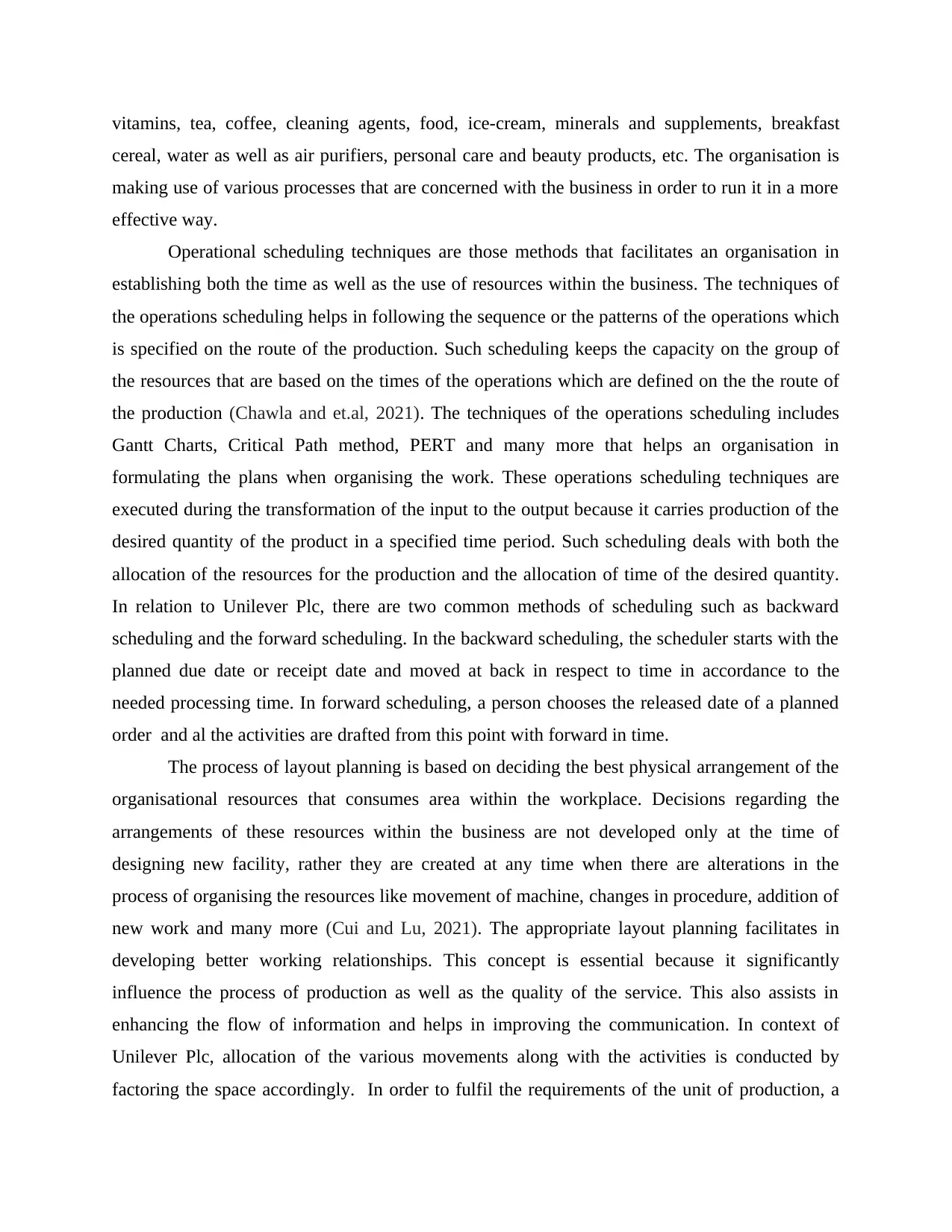
vitamins, tea, coffee, cleaning agents, food, ice-cream, minerals and supplements, breakfast
cereal, water as well as air purifiers, personal care and beauty products, etc. The organisation is
making use of various processes that are concerned with the business in order to run it in a more
effective way.
Operational scheduling techniques are those methods that facilitates an organisation in
establishing both the time as well as the use of resources within the business. The techniques of
the operations scheduling helps in following the sequence or the patterns of the operations which
is specified on the route of the production. Such scheduling keeps the capacity on the group of
the resources that are based on the times of the operations which are defined on the the route of
the production (Chawla and et.al, 2021). The techniques of the operations scheduling includes
Gantt Charts, Critical Path method, PERT and many more that helps an organisation in
formulating the plans when organising the work. These operations scheduling techniques are
executed during the transformation of the input to the output because it carries production of the
desired quantity of the product in a specified time period. Such scheduling deals with both the
allocation of the resources for the production and the allocation of time of the desired quantity.
In relation to Unilever Plc, there are two common methods of scheduling such as backward
scheduling and the forward scheduling. In the backward scheduling, the scheduler starts with the
planned due date or receipt date and moved at back in respect to time in accordance to the
needed processing time. In forward scheduling, a person chooses the released date of a planned
order and al the activities are drafted from this point with forward in time.
The process of layout planning is based on deciding the best physical arrangement of the
organisational resources that consumes area within the workplace. Decisions regarding the
arrangements of these resources within the business are not developed only at the time of
designing new facility, rather they are created at any time when there are alterations in the
process of organising the resources like movement of machine, changes in procedure, addition of
new work and many more (Cui and Lu, 2021). The appropriate layout planning facilitates in
developing better working relationships. This concept is essential because it significantly
influence the process of production as well as the quality of the service. This also assists in
enhancing the flow of information and helps in improving the communication. In context of
Unilever Plc, allocation of the various movements along with the activities is conducted by
factoring the space accordingly. In order to fulfil the requirements of the unit of production, a
cereal, water as well as air purifiers, personal care and beauty products, etc. The organisation is
making use of various processes that are concerned with the business in order to run it in a more
effective way.
Operational scheduling techniques are those methods that facilitates an organisation in
establishing both the time as well as the use of resources within the business. The techniques of
the operations scheduling helps in following the sequence or the patterns of the operations which
is specified on the route of the production. Such scheduling keeps the capacity on the group of
the resources that are based on the times of the operations which are defined on the the route of
the production (Chawla and et.al, 2021). The techniques of the operations scheduling includes
Gantt Charts, Critical Path method, PERT and many more that helps an organisation in
formulating the plans when organising the work. These operations scheduling techniques are
executed during the transformation of the input to the output because it carries production of the
desired quantity of the product in a specified time period. Such scheduling deals with both the
allocation of the resources for the production and the allocation of time of the desired quantity.
In relation to Unilever Plc, there are two common methods of scheduling such as backward
scheduling and the forward scheduling. In the backward scheduling, the scheduler starts with the
planned due date or receipt date and moved at back in respect to time in accordance to the
needed processing time. In forward scheduling, a person chooses the released date of a planned
order and al the activities are drafted from this point with forward in time.
The process of layout planning is based on deciding the best physical arrangement of the
organisational resources that consumes area within the workplace. Decisions regarding the
arrangements of these resources within the business are not developed only at the time of
designing new facility, rather they are created at any time when there are alterations in the
process of organising the resources like movement of machine, changes in procedure, addition of
new work and many more (Cui and Lu, 2021). The appropriate layout planning facilitates in
developing better working relationships. This concept is essential because it significantly
influence the process of production as well as the quality of the service. This also assists in
enhancing the flow of information and helps in improving the communication. In context of
Unilever Plc, allocation of the various movements along with the activities is conducted by
factoring the space accordingly. In order to fulfil the requirements of the unit of production, a
Paraphrase This Document
Need a fresh take? Get an instant paraphrase of this document with our AI Paraphraser
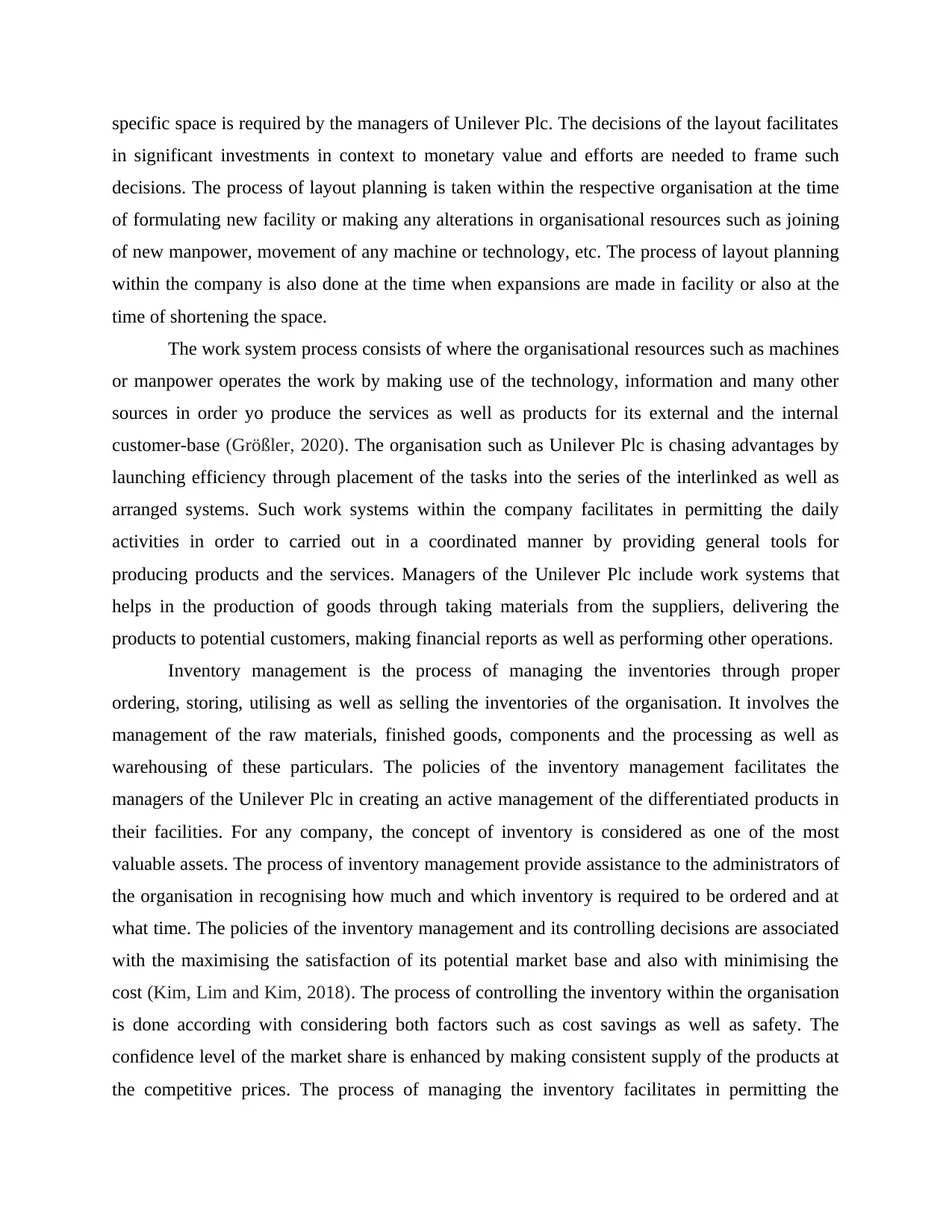
specific space is required by the managers of Unilever Plc. The decisions of the layout facilitates
in significant investments in context to monetary value and efforts are needed to frame such
decisions. The process of layout planning is taken within the respective organisation at the time
of formulating new facility or making any alterations in organisational resources such as joining
of new manpower, movement of any machine or technology, etc. The process of layout planning
within the company is also done at the time when expansions are made in facility or also at the
time of shortening the space.
The work system process consists of where the organisational resources such as machines
or manpower operates the work by making use of the technology, information and many other
sources in order yo produce the services as well as products for its external and the internal
customer-base (Größler, 2020). The organisation such as Unilever Plc is chasing advantages by
launching efficiency through placement of the tasks into the series of the interlinked as well as
arranged systems. Such work systems within the company facilitates in permitting the daily
activities in order to carried out in a coordinated manner by providing general tools for
producing products and the services. Managers of the Unilever Plc include work systems that
helps in the production of goods through taking materials from the suppliers, delivering the
products to potential customers, making financial reports as well as performing other operations.
Inventory management is the process of managing the inventories through proper
ordering, storing, utilising as well as selling the inventories of the organisation. It involves the
management of the raw materials, finished goods, components and the processing as well as
warehousing of these particulars. The policies of the inventory management facilitates the
managers of the Unilever Plc in creating an active management of the differentiated products in
their facilities. For any company, the concept of inventory is considered as one of the most
valuable assets. The process of inventory management provide assistance to the administrators of
the organisation in recognising how much and which inventory is required to be ordered and at
what time. The policies of the inventory management and its controlling decisions are associated
with the maximising the satisfaction of its potential market base and also with minimising the
cost (Kim, Lim and Kim, 2018). The process of controlling the inventory within the organisation
is done according with considering both factors such as cost savings as well as safety. The
confidence level of the market share is enhanced by making consistent supply of the products at
the competitive prices. The process of managing the inventory facilitates in permitting the
in significant investments in context to monetary value and efforts are needed to frame such
decisions. The process of layout planning is taken within the respective organisation at the time
of formulating new facility or making any alterations in organisational resources such as joining
of new manpower, movement of any machine or technology, etc. The process of layout planning
within the company is also done at the time when expansions are made in facility or also at the
time of shortening the space.
The work system process consists of where the organisational resources such as machines
or manpower operates the work by making use of the technology, information and many other
sources in order yo produce the services as well as products for its external and the internal
customer-base (Größler, 2020). The organisation such as Unilever Plc is chasing advantages by
launching efficiency through placement of the tasks into the series of the interlinked as well as
arranged systems. Such work systems within the company facilitates in permitting the daily
activities in order to carried out in a coordinated manner by providing general tools for
producing products and the services. Managers of the Unilever Plc include work systems that
helps in the production of goods through taking materials from the suppliers, delivering the
products to potential customers, making financial reports as well as performing other operations.
Inventory management is the process of managing the inventories through proper
ordering, storing, utilising as well as selling the inventories of the organisation. It involves the
management of the raw materials, finished goods, components and the processing as well as
warehousing of these particulars. The policies of the inventory management facilitates the
managers of the Unilever Plc in creating an active management of the differentiated products in
their facilities. For any company, the concept of inventory is considered as one of the most
valuable assets. The process of inventory management provide assistance to the administrators of
the organisation in recognising how much and which inventory is required to be ordered and at
what time. The policies of the inventory management and its controlling decisions are associated
with the maximising the satisfaction of its potential market base and also with minimising the
cost (Kim, Lim and Kim, 2018). The process of controlling the inventory within the organisation
is done according with considering both factors such as cost savings as well as safety. The
confidence level of the market share is enhanced by making consistent supply of the products at
the competitive prices. The process of managing the inventory facilitates in permitting the
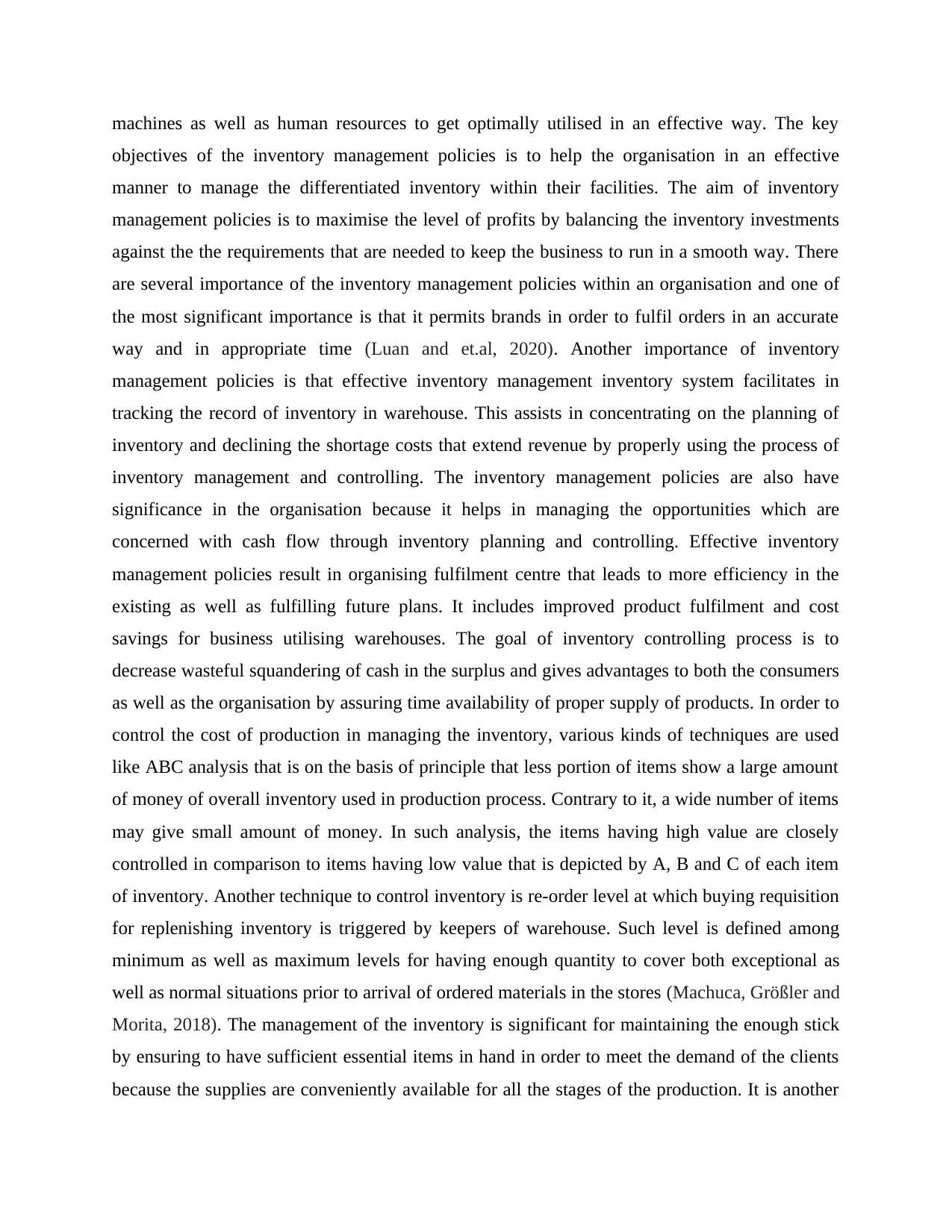
machines as well as human resources to get optimally utilised in an effective way. The key
objectives of the inventory management policies is to help the organisation in an effective
manner to manage the differentiated inventory within their facilities. The aim of inventory
management policies is to maximise the level of profits by balancing the inventory investments
against the the requirements that are needed to keep the business to run in a smooth way. There
are several importance of the inventory management policies within an organisation and one of
the most significant importance is that it permits brands in order to fulfil orders in an accurate
way and in appropriate time (Luan and et.al, 2020). Another importance of inventory
management policies is that effective inventory management inventory system facilitates in
tracking the record of inventory in warehouse. This assists in concentrating on the planning of
inventory and declining the shortage costs that extend revenue by properly using the process of
inventory management and controlling. The inventory management policies are also have
significance in the organisation because it helps in managing the opportunities which are
concerned with cash flow through inventory planning and controlling. Effective inventory
management policies result in organising fulfilment centre that leads to more efficiency in the
existing as well as fulfilling future plans. It includes improved product fulfilment and cost
savings for business utilising warehouses. The goal of inventory controlling process is to
decrease wasteful squandering of cash in the surplus and gives advantages to both the consumers
as well as the organisation by assuring time availability of proper supply of products. In order to
control the cost of production in managing the inventory, various kinds of techniques are used
like ABC analysis that is on the basis of principle that less portion of items show a large amount
of money of overall inventory used in production process. Contrary to it, a wide number of items
may give small amount of money. In such analysis, the items having high value are closely
controlled in comparison to items having low value that is depicted by A, B and C of each item
of inventory. Another technique to control inventory is re-order level at which buying requisition
for replenishing inventory is triggered by keepers of warehouse. Such level is defined among
minimum as well as maximum levels for having enough quantity to cover both exceptional as
well as normal situations prior to arrival of ordered materials in the stores (Machuca, Größler and
Morita, 2018). The management of the inventory is significant for maintaining the enough stick
by ensuring to have sufficient essential items in hand in order to meet the demand of the clients
because the supplies are conveniently available for all the stages of the production. It is another
objectives of the inventory management policies is to help the organisation in an effective
manner to manage the differentiated inventory within their facilities. The aim of inventory
management policies is to maximise the level of profits by balancing the inventory investments
against the the requirements that are needed to keep the business to run in a smooth way. There
are several importance of the inventory management policies within an organisation and one of
the most significant importance is that it permits brands in order to fulfil orders in an accurate
way and in appropriate time (Luan and et.al, 2020). Another importance of inventory
management policies is that effective inventory management inventory system facilitates in
tracking the record of inventory in warehouse. This assists in concentrating on the planning of
inventory and declining the shortage costs that extend revenue by properly using the process of
inventory management and controlling. The inventory management policies are also have
significance in the organisation because it helps in managing the opportunities which are
concerned with cash flow through inventory planning and controlling. Effective inventory
management policies result in organising fulfilment centre that leads to more efficiency in the
existing as well as fulfilling future plans. It includes improved product fulfilment and cost
savings for business utilising warehouses. The goal of inventory controlling process is to
decrease wasteful squandering of cash in the surplus and gives advantages to both the consumers
as well as the organisation by assuring time availability of proper supply of products. In order to
control the cost of production in managing the inventory, various kinds of techniques are used
like ABC analysis that is on the basis of principle that less portion of items show a large amount
of money of overall inventory used in production process. Contrary to it, a wide number of items
may give small amount of money. In such analysis, the items having high value are closely
controlled in comparison to items having low value that is depicted by A, B and C of each item
of inventory. Another technique to control inventory is re-order level at which buying requisition
for replenishing inventory is triggered by keepers of warehouse. Such level is defined among
minimum as well as maximum levels for having enough quantity to cover both exceptional as
well as normal situations prior to arrival of ordered materials in the stores (Machuca, Größler and
Morita, 2018). The management of the inventory is significant for maintaining the enough stick
by ensuring to have sufficient essential items in hand in order to meet the demand of the clients
because the supplies are conveniently available for all the stages of the production. It is another
⊘ This is a preview!⊘
Do you want full access?
Subscribe today to unlock all pages.

Trusted by 1+ million students worldwide
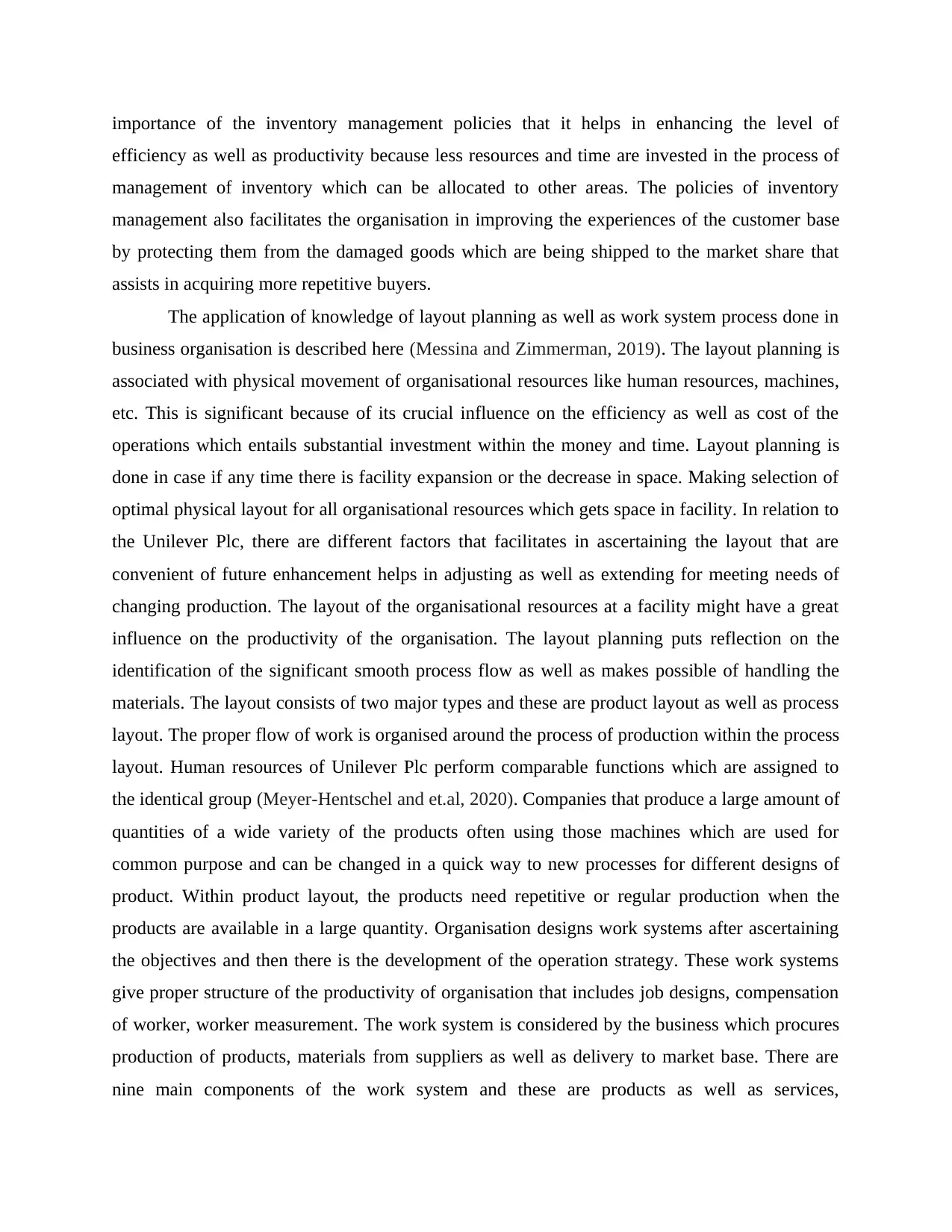
importance of the inventory management policies that it helps in enhancing the level of
efficiency as well as productivity because less resources and time are invested in the process of
management of inventory which can be allocated to other areas. The policies of inventory
management also facilitates the organisation in improving the experiences of the customer base
by protecting them from the damaged goods which are being shipped to the market share that
assists in acquiring more repetitive buyers.
The application of knowledge of layout planning as well as work system process done in
business organisation is described here (Messina and Zimmerman, 2019). The layout planning is
associated with physical movement of organisational resources like human resources, machines,
etc. This is significant because of its crucial influence on the efficiency as well as cost of the
operations which entails substantial investment within the money and time. Layout planning is
done in case if any time there is facility expansion or the decrease in space. Making selection of
optimal physical layout for all organisational resources which gets space in facility. In relation to
the Unilever Plc, there are different factors that facilitates in ascertaining the layout that are
convenient of future enhancement helps in adjusting as well as extending for meeting needs of
changing production. The layout of the organisational resources at a facility might have a great
influence on the productivity of the organisation. The layout planning puts reflection on the
identification of the significant smooth process flow as well as makes possible of handling the
materials. The layout consists of two major types and these are product layout as well as process
layout. The proper flow of work is organised around the process of production within the process
layout. Human resources of Unilever Plc perform comparable functions which are assigned to
the identical group (Meyer-Hentschel and et.al, 2020). Companies that produce a large amount of
quantities of a wide variety of the products often using those machines which are used for
common purpose and can be changed in a quick way to new processes for different designs of
product. Within product layout, the products need repetitive or regular production when the
products are available in a large quantity. Organisation designs work systems after ascertaining
the objectives and then there is the development of the operation strategy. These work systems
give proper structure of the productivity of organisation that includes job designs, compensation
of worker, worker measurement. The work system is considered by the business which procures
production of products, materials from suppliers as well as delivery to market base. There are
nine main components of the work system and these are products as well as services,
efficiency as well as productivity because less resources and time are invested in the process of
management of inventory which can be allocated to other areas. The policies of inventory
management also facilitates the organisation in improving the experiences of the customer base
by protecting them from the damaged goods which are being shipped to the market share that
assists in acquiring more repetitive buyers.
The application of knowledge of layout planning as well as work system process done in
business organisation is described here (Messina and Zimmerman, 2019). The layout planning is
associated with physical movement of organisational resources like human resources, machines,
etc. This is significant because of its crucial influence on the efficiency as well as cost of the
operations which entails substantial investment within the money and time. Layout planning is
done in case if any time there is facility expansion or the decrease in space. Making selection of
optimal physical layout for all organisational resources which gets space in facility. In relation to
the Unilever Plc, there are different factors that facilitates in ascertaining the layout that are
convenient of future enhancement helps in adjusting as well as extending for meeting needs of
changing production. The layout of the organisational resources at a facility might have a great
influence on the productivity of the organisation. The layout planning puts reflection on the
identification of the significant smooth process flow as well as makes possible of handling the
materials. The layout consists of two major types and these are product layout as well as process
layout. The proper flow of work is organised around the process of production within the process
layout. Human resources of Unilever Plc perform comparable functions which are assigned to
the identical group (Meyer-Hentschel and et.al, 2020). Companies that produce a large amount of
quantities of a wide variety of the products often using those machines which are used for
common purpose and can be changed in a quick way to new processes for different designs of
product. Within product layout, the products need repetitive or regular production when the
products are available in a large quantity. Organisation designs work systems after ascertaining
the objectives and then there is the development of the operation strategy. These work systems
give proper structure of the productivity of organisation that includes job designs, compensation
of worker, worker measurement. The work system is considered by the business which procures
production of products, materials from suppliers as well as delivery to market base. There are
nine main components of the work system and these are products as well as services,
Paraphrase This Document
Need a fresh take? Get an instant paraphrase of this document with our AI Paraphraser
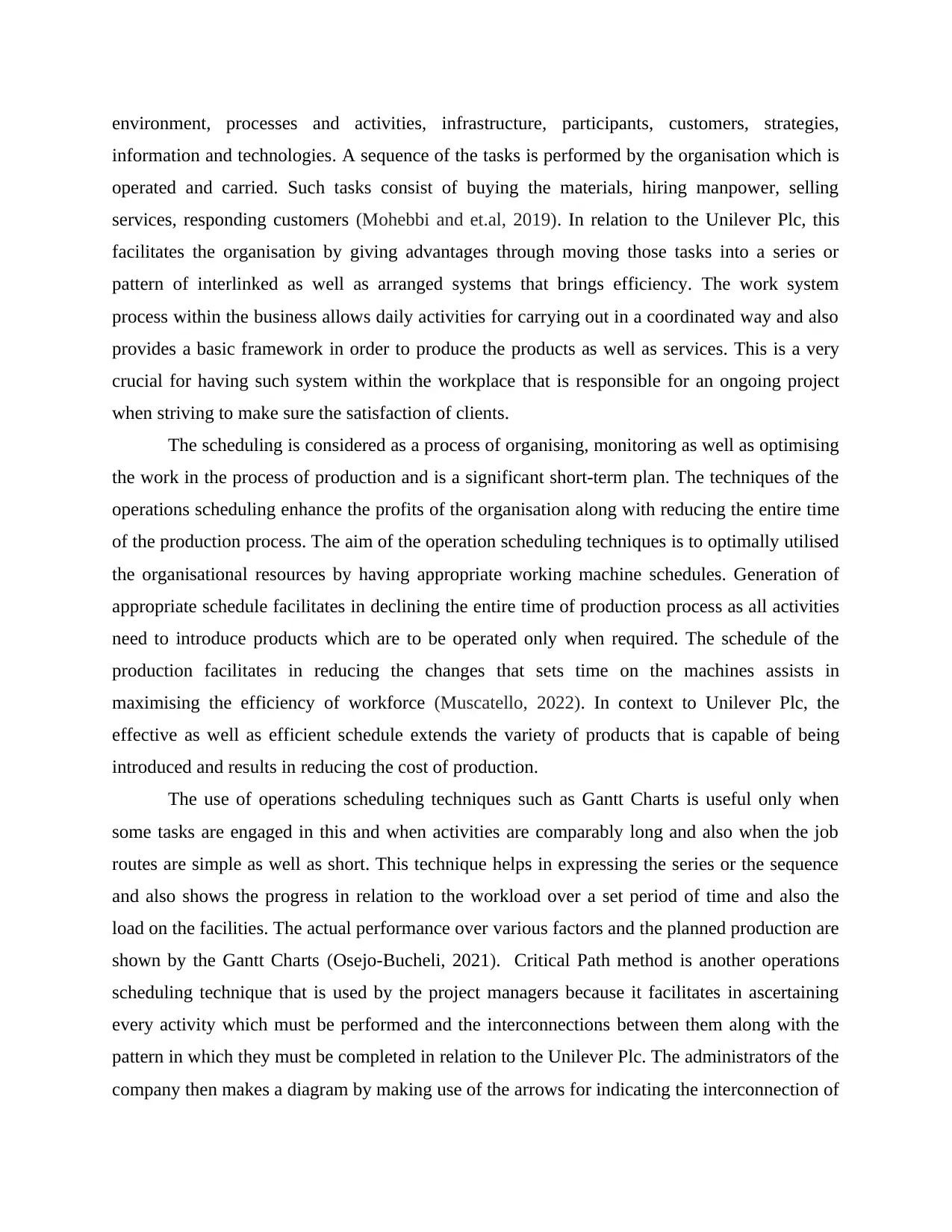
environment, processes and activities, infrastructure, participants, customers, strategies,
information and technologies. A sequence of the tasks is performed by the organisation which is
operated and carried. Such tasks consist of buying the materials, hiring manpower, selling
services, responding customers (Mohebbi and et.al, 2019). In relation to the Unilever Plc, this
facilitates the organisation by giving advantages through moving those tasks into a series or
pattern of interlinked as well as arranged systems that brings efficiency. The work system
process within the business allows daily activities for carrying out in a coordinated way and also
provides a basic framework in order to produce the products as well as services. This is a very
crucial for having such system within the workplace that is responsible for an ongoing project
when striving to make sure the satisfaction of clients.
The scheduling is considered as a process of organising, monitoring as well as optimising
the work in the process of production and is a significant short-term plan. The techniques of the
operations scheduling enhance the profits of the organisation along with reducing the entire time
of the production process. The aim of the operation scheduling techniques is to optimally utilised
the organisational resources by having appropriate working machine schedules. Generation of
appropriate schedule facilitates in declining the entire time of production process as all activities
need to introduce products which are to be operated only when required. The schedule of the
production facilitates in reducing the changes that sets time on the machines assists in
maximising the efficiency of workforce (Muscatello, 2022). In context to Unilever Plc, the
effective as well as efficient schedule extends the variety of products that is capable of being
introduced and results in reducing the cost of production.
The use of operations scheduling techniques such as Gantt Charts is useful only when
some tasks are engaged in this and when activities are comparably long and also when the job
routes are simple as well as short. This technique helps in expressing the series or the sequence
and also shows the progress in relation to the workload over a set period of time and also the
load on the facilities. The actual performance over various factors and the planned production are
shown by the Gantt Charts (Osejo-Bucheli, 2021). Critical Path method is another operations
scheduling technique that is used by the project managers because it facilitates in ascertaining
every activity which must be performed and the interconnections between them along with the
pattern in which they must be completed in relation to the Unilever Plc. The administrators of the
company then makes a diagram by making use of the arrows for indicating the interconnection of
information and technologies. A sequence of the tasks is performed by the organisation which is
operated and carried. Such tasks consist of buying the materials, hiring manpower, selling
services, responding customers (Mohebbi and et.al, 2019). In relation to the Unilever Plc, this
facilitates the organisation by giving advantages through moving those tasks into a series or
pattern of interlinked as well as arranged systems that brings efficiency. The work system
process within the business allows daily activities for carrying out in a coordinated way and also
provides a basic framework in order to produce the products as well as services. This is a very
crucial for having such system within the workplace that is responsible for an ongoing project
when striving to make sure the satisfaction of clients.
The scheduling is considered as a process of organising, monitoring as well as optimising
the work in the process of production and is a significant short-term plan. The techniques of the
operations scheduling enhance the profits of the organisation along with reducing the entire time
of the production process. The aim of the operation scheduling techniques is to optimally utilised
the organisational resources by having appropriate working machine schedules. Generation of
appropriate schedule facilitates in declining the entire time of production process as all activities
need to introduce products which are to be operated only when required. The schedule of the
production facilitates in reducing the changes that sets time on the machines assists in
maximising the efficiency of workforce (Muscatello, 2022). In context to Unilever Plc, the
effective as well as efficient schedule extends the variety of products that is capable of being
introduced and results in reducing the cost of production.
The use of operations scheduling techniques such as Gantt Charts is useful only when
some tasks are engaged in this and when activities are comparably long and also when the job
routes are simple as well as short. This technique helps in expressing the series or the sequence
and also shows the progress in relation to the workload over a set period of time and also the
load on the facilities. The actual performance over various factors and the planned production are
shown by the Gantt Charts (Osejo-Bucheli, 2021). Critical Path method is another operations
scheduling technique that is used by the project managers because it facilitates in ascertaining
every activity which must be performed and the interconnections between them along with the
pattern in which they must be completed in relation to the Unilever Plc. The administrators of the
company then makes a diagram by making use of the arrows for indicating the interconnection of
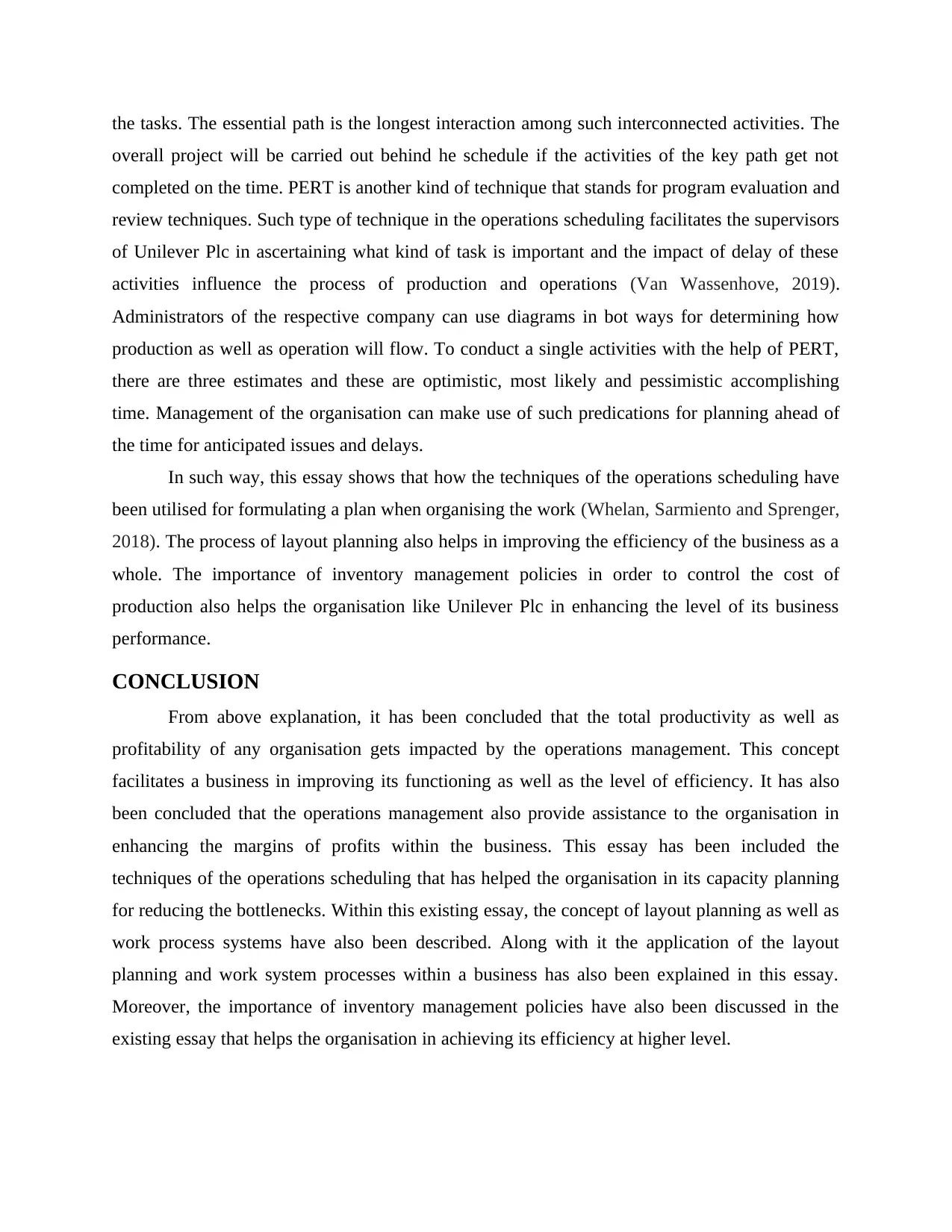
the tasks. The essential path is the longest interaction among such interconnected activities. The
overall project will be carried out behind he schedule if the activities of the key path get not
completed on the time. PERT is another kind of technique that stands for program evaluation and
review techniques. Such type of technique in the operations scheduling facilitates the supervisors
of Unilever Plc in ascertaining what kind of task is important and the impact of delay of these
activities influence the process of production and operations (Van Wassenhove, 2019).
Administrators of the respective company can use diagrams in bot ways for determining how
production as well as operation will flow. To conduct a single activities with the help of PERT,
there are three estimates and these are optimistic, most likely and pessimistic accomplishing
time. Management of the organisation can make use of such predications for planning ahead of
the time for anticipated issues and delays.
In such way, this essay shows that how the techniques of the operations scheduling have
been utilised for formulating a plan when organising the work (Whelan, Sarmiento and Sprenger,
2018). The process of layout planning also helps in improving the efficiency of the business as a
whole. The importance of inventory management policies in order to control the cost of
production also helps the organisation like Unilever Plc in enhancing the level of its business
performance.
CONCLUSION
From above explanation, it has been concluded that the total productivity as well as
profitability of any organisation gets impacted by the operations management. This concept
facilitates a business in improving its functioning as well as the level of efficiency. It has also
been concluded that the operations management also provide assistance to the organisation in
enhancing the margins of profits within the business. This essay has been included the
techniques of the operations scheduling that has helped the organisation in its capacity planning
for reducing the bottlenecks. Within this existing essay, the concept of layout planning as well as
work process systems have also been described. Along with it the application of the layout
planning and work system processes within a business has also been explained in this essay.
Moreover, the importance of inventory management policies have also been discussed in the
existing essay that helps the organisation in achieving its efficiency at higher level.
overall project will be carried out behind he schedule if the activities of the key path get not
completed on the time. PERT is another kind of technique that stands for program evaluation and
review techniques. Such type of technique in the operations scheduling facilitates the supervisors
of Unilever Plc in ascertaining what kind of task is important and the impact of delay of these
activities influence the process of production and operations (Van Wassenhove, 2019).
Administrators of the respective company can use diagrams in bot ways for determining how
production as well as operation will flow. To conduct a single activities with the help of PERT,
there are three estimates and these are optimistic, most likely and pessimistic accomplishing
time. Management of the organisation can make use of such predications for planning ahead of
the time for anticipated issues and delays.
In such way, this essay shows that how the techniques of the operations scheduling have
been utilised for formulating a plan when organising the work (Whelan, Sarmiento and Sprenger,
2018). The process of layout planning also helps in improving the efficiency of the business as a
whole. The importance of inventory management policies in order to control the cost of
production also helps the organisation like Unilever Plc in enhancing the level of its business
performance.
CONCLUSION
From above explanation, it has been concluded that the total productivity as well as
profitability of any organisation gets impacted by the operations management. This concept
facilitates a business in improving its functioning as well as the level of efficiency. It has also
been concluded that the operations management also provide assistance to the organisation in
enhancing the margins of profits within the business. This essay has been included the
techniques of the operations scheduling that has helped the organisation in its capacity planning
for reducing the bottlenecks. Within this existing essay, the concept of layout planning as well as
work process systems have also been described. Along with it the application of the layout
planning and work system processes within a business has also been explained in this essay.
Moreover, the importance of inventory management policies have also been discussed in the
existing essay that helps the organisation in achieving its efficiency at higher level.
⊘ This is a preview!⊘
Do you want full access?
Subscribe today to unlock all pages.

Trusted by 1+ million students worldwide
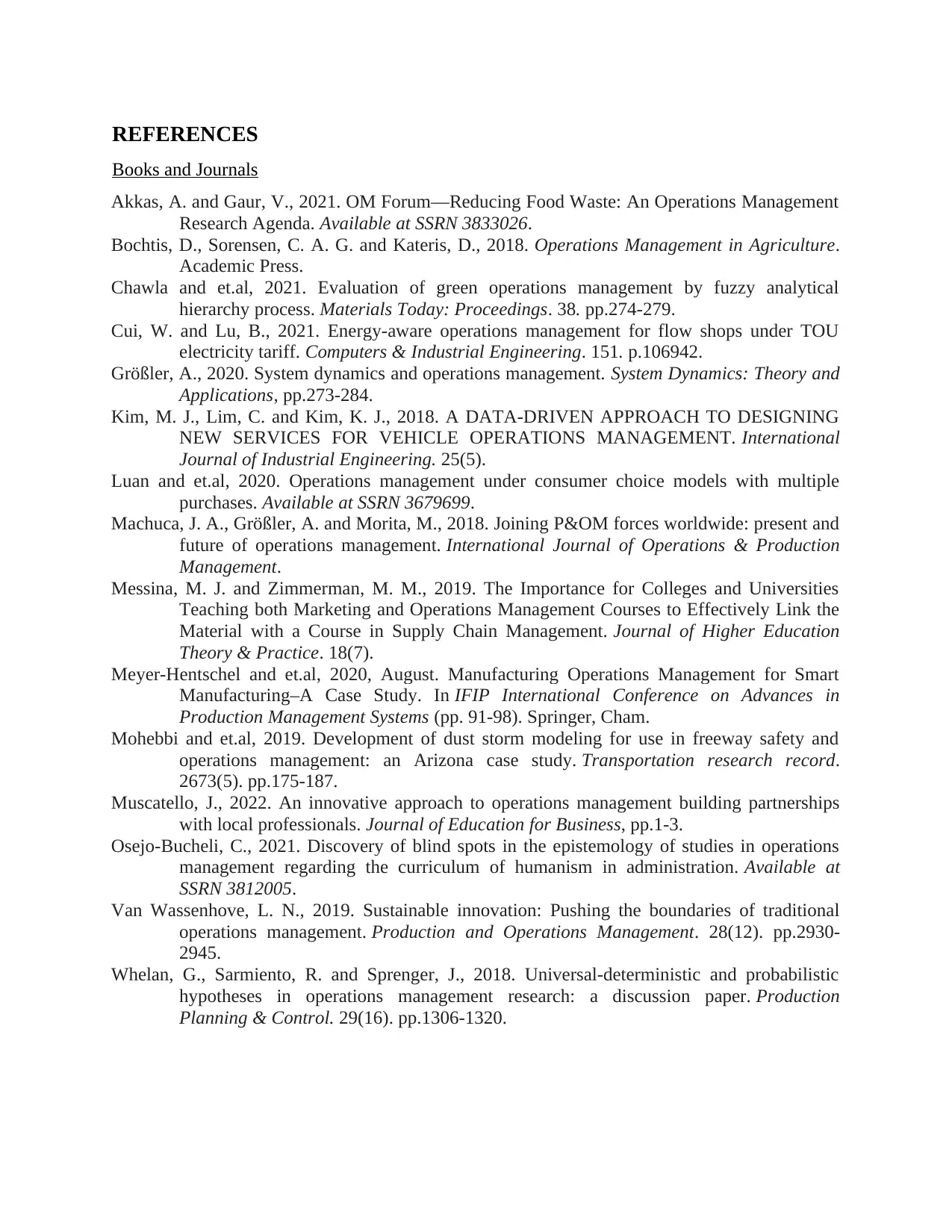
REFERENCES
Books and Journals
Akkas, A. and Gaur, V., 2021. OM Forum—Reducing Food Waste: An Operations Management
Research Agenda. Available at SSRN 3833026.
Bochtis, D., Sorensen, C. A. G. and Kateris, D., 2018. Operations Management in Agriculture.
Academic Press.
Chawla and et.al, 2021. Evaluation of green operations management by fuzzy analytical
hierarchy process. Materials Today: Proceedings. 38. pp.274-279.
Cui, W. and Lu, B., 2021. Energy-aware operations management for flow shops under TOU
electricity tariff. Computers & Industrial Engineering. 151. p.106942.
Größler, A., 2020. System dynamics and operations management. System Dynamics: Theory and
Applications, pp.273-284.
Kim, M. J., Lim, C. and Kim, K. J., 2018. A DATA-DRIVEN APPROACH TO DESIGNING
NEW SERVICES FOR VEHICLE OPERATIONS MANAGEMENT. International
Journal of Industrial Engineering. 25(5).
Luan and et.al, 2020. Operations management under consumer choice models with multiple
purchases. Available at SSRN 3679699.
Machuca, J. A., Größler, A. and Morita, M., 2018. Joining P&OM forces worldwide: present and
future of operations management. International Journal of Operations & Production
Management.
Messina, M. J. and Zimmerman, M. M., 2019. The Importance for Colleges and Universities
Teaching both Marketing and Operations Management Courses to Effectively Link the
Material with a Course in Supply Chain Management. Journal of Higher Education
Theory & Practice. 18(7).
Meyer-Hentschel and et.al, 2020, August. Manufacturing Operations Management for Smart
Manufacturing–A Case Study. In IFIP International Conference on Advances in
Production Management Systems (pp. 91-98). Springer, Cham.
Mohebbi and et.al, 2019. Development of dust storm modeling for use in freeway safety and
operations management: an Arizona case study. Transportation research record.
2673(5). pp.175-187.
Muscatello, J., 2022. An innovative approach to operations management building partnerships
with local professionals. Journal of Education for Business, pp.1-3.
Osejo-Bucheli, C., 2021. Discovery of blind spots in the epistemology of studies in operations
management regarding the curriculum of humanism in administration. Available at
SSRN 3812005.
Van Wassenhove, L. N., 2019. Sustainable innovation: Pushing the boundaries of traditional
operations management. Production and Operations Management. 28(12). pp.2930-
2945.
Whelan, G., Sarmiento, R. and Sprenger, J., 2018. Universal-deterministic and probabilistic
hypotheses in operations management research: a discussion paper. Production
Planning & Control. 29(16). pp.1306-1320.
Books and Journals
Akkas, A. and Gaur, V., 2021. OM Forum—Reducing Food Waste: An Operations Management
Research Agenda. Available at SSRN 3833026.
Bochtis, D., Sorensen, C. A. G. and Kateris, D., 2018. Operations Management in Agriculture.
Academic Press.
Chawla and et.al, 2021. Evaluation of green operations management by fuzzy analytical
hierarchy process. Materials Today: Proceedings. 38. pp.274-279.
Cui, W. and Lu, B., 2021. Energy-aware operations management for flow shops under TOU
electricity tariff. Computers & Industrial Engineering. 151. p.106942.
Größler, A., 2020. System dynamics and operations management. System Dynamics: Theory and
Applications, pp.273-284.
Kim, M. J., Lim, C. and Kim, K. J., 2018. A DATA-DRIVEN APPROACH TO DESIGNING
NEW SERVICES FOR VEHICLE OPERATIONS MANAGEMENT. International
Journal of Industrial Engineering. 25(5).
Luan and et.al, 2020. Operations management under consumer choice models with multiple
purchases. Available at SSRN 3679699.
Machuca, J. A., Größler, A. and Morita, M., 2018. Joining P&OM forces worldwide: present and
future of operations management. International Journal of Operations & Production
Management.
Messina, M. J. and Zimmerman, M. M., 2019. The Importance for Colleges and Universities
Teaching both Marketing and Operations Management Courses to Effectively Link the
Material with a Course in Supply Chain Management. Journal of Higher Education
Theory & Practice. 18(7).
Meyer-Hentschel and et.al, 2020, August. Manufacturing Operations Management for Smart
Manufacturing–A Case Study. In IFIP International Conference on Advances in
Production Management Systems (pp. 91-98). Springer, Cham.
Mohebbi and et.al, 2019. Development of dust storm modeling for use in freeway safety and
operations management: an Arizona case study. Transportation research record.
2673(5). pp.175-187.
Muscatello, J., 2022. An innovative approach to operations management building partnerships
with local professionals. Journal of Education for Business, pp.1-3.
Osejo-Bucheli, C., 2021. Discovery of blind spots in the epistemology of studies in operations
management regarding the curriculum of humanism in administration. Available at
SSRN 3812005.
Van Wassenhove, L. N., 2019. Sustainable innovation: Pushing the boundaries of traditional
operations management. Production and Operations Management. 28(12). pp.2930-
2945.
Whelan, G., Sarmiento, R. and Sprenger, J., 2018. Universal-deterministic and probabilistic
hypotheses in operations management research: a discussion paper. Production
Planning & Control. 29(16). pp.1306-1320.
1 out of 10
Related Documents
Your All-in-One AI-Powered Toolkit for Academic Success.
+13062052269
info@desklib.com
Available 24*7 on WhatsApp / Email
![[object Object]](/_next/static/media/star-bottom.7253800d.svg)
Unlock your academic potential
Copyright © 2020–2025 A2Z Services. All Rights Reserved. Developed and managed by ZUCOL.




